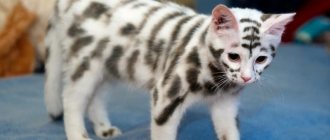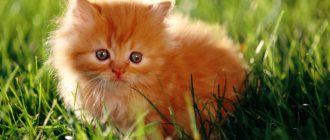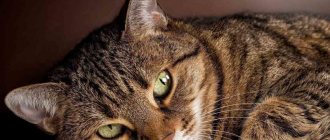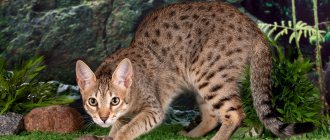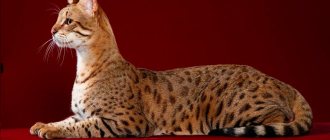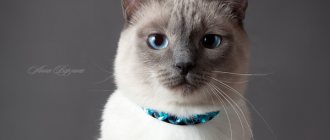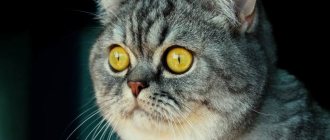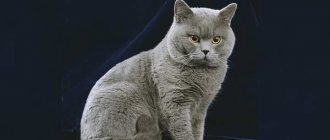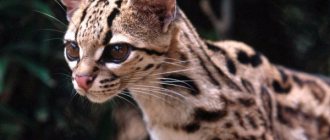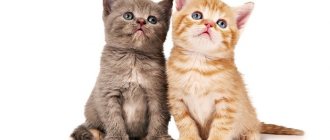What is ticking?
Cats with fur of this color really look very attractive and unusual. The fur coat of such pets does not have the usual stripes and at the same time it does not look monochromatic.
The ticked color of cats is also called “color without color.” In this case, the stripes are not located directly on the animal’s body, but on each individual hair. A cat with such fur looks as if covered with freckles. When such an animal moves, its fur seems to shimmer and shine. Many people believe that this coloring is very similar to the colors of squirrels or chinchillas.
Main characteristics of color
A cat's coat can only be recognized as ticked if:
- there is no extraneous pattern at all on the animal’s body - neither clear nor blurry;
- On each hair on the animal’s fur there are several dark and light stripes (at least 3 dark stripes).
The ticked color of cats, among other things, allows for stripes on the tip of the tail and paws, the presence of a “necklace” on the neck, as well as stripes in the shape of the letter “M” on the forehead. Such drawings are not considered a reason for disqualifying cats of any breed except Abyssinian.
Modification and variety
Three color modifications are classified.
- Broken Mackerel - differs from the usual one in that the even stripes running throughout the body are interrupted.
- Marbled – the characteristic spots in the classic version look a little blurry and clouded. It can occur not only in purebred animals, but also in domestic animals. This is caused by a mixture of breeds.
- Ticked - there is a residual pattern on the paws, neck and chest in the form of rings.
Types of ticked cat colors
In addition to Abyssinians, cats of the following breeds can have such coat colors today:
- Scottish and British;
- American Wirehair, Miniature, Shorthair;
- bobtail;
- American Curl;
- Persian;
- Maine Coon;
- Ceylonese;
- Devon Rex;
- munchkin and some others.
There are 9 main types of ticked colors in cats:
- black;
- cream;
- blue;
- chocolate;
- cinnamon;
- red;
- lilac;
- gold;
- faun.
Existing colors of cats and cats
Colors of British cats: marbled, beige, lilac
The most common colors found in nature are black and red, as well as two-color colors. Tri-colored and white cats are rarely born; cats are practically never like this.
For your information! The most beautiful colors of purebred cats and cats are formed on the basis of the main ones. They are called king point, tabby, silver, gold, etc.
Two-color (color and white)
If the cat is white with gray spots around the head or tail, the color is called van. At the genetic level, a cat's fur is colored black, red, blue or another color, but most of its coat is covered by a huge white spot.
If the fur is covered with colored spots by more than a third, the color is called harlequin, and if by half, then an almost white cat is the owner of a bicolor color.
Note! The biggest problem with pure white cats is deafness. But this is not about illness. White coloring in deaf kittens appears in 45% of cases. The reason for this is the binding of an auditory hereditary trait to the W (pure white) or S (white spots) gene.
Albinism and color point
Albino cats have nothing to do with white cats, since a separate hereditary trait is responsible for albinism - C. There are two types of albino cat colors: blue-eyed © and red-eyed (CA). If C is dominant, albinism does not appear.
The term “point” is used to describe some exotic cats, for example, Scottish Fold longhairs. Characteristic signs of the latter are the localization of dark spots on the face, paws, ears and tail. The remaining parts of the fur are colorless.
Points form in areas of the body where the temperature is low. The color of the color point also depends on the temperature.
Group of solid colors
The solid group includes pure black, blue, chocolate, lilac, red and pale yellow cats, as well as animals uniformly colored by nature in the colors of cinnamon and fawn.
Representatives of solid colors
For your information! Bright representatives of solid colors are Asian longhaired, American shorthaired, wirehaired and miniature cats, as well as American bobtails.
Silver and gold
With a silver color in cats, the hairs are either devoid of pigment at the roots, or the whitish paint appears very faintly, and the ends are painted in a much brighter color.
Gold-colored fur in cats acquires a reddish tint with a reddish tint (more or less intense), and the tips are very brightly colored. Owners of a golden coat are characterized by green eye color.
What colors are ticking and tabby cats, agouti and non-agouti?
Ticking is the zonal coloring of hairs, with alternating black and yellow pigments. Tickling occurs when an agouti or dominant hereditary trait is present in the animal's genotype. A striking example of ticked colors is the fur coat of Abyssinian cats.
Ticked tabbies are the colors of cats when the guard (integumentary) hairs are either very long, straight and well developed, or have a scaly structure and a slightly curved shaft. Towards the middle the hairs are slightly thickened. The top of each hair resembles a cone.
Ticking appears under the influence of dominant agouti (A). The 1st stage of wool growth is characterized by active pigment release. The hairs are colored depending on the gene adjacent to the agouti. At the 2nd stage of development of the agouti color in cats, pigment production slows down, due to which some areas of the hairs become lighter. Ticking (zoned coloring of hairs) is the alternation of the two growth stages just described.
For your information! The phenomenon in which colored areas are localized only in a certain place is called tipping.
Torty Links Point
Owners of this color are usually representatives of exotic breeds, for example, blue-eyed Persian cats. Their almost white coats are decorated with dark spots around the head, paws and tail.
Gray (blue)
The most common. For a number of breeds, the bluish-gray color of cats is a sign of high origin. These breeds include Russian Blue and British Blue cats, as well as representatives of the Chartreuse, Nibelung and Korat breeds. Gray color is characteristic of Persian, Angora and Maltese cats.
British blue cat
Golden and amber
The fur of those with a golden color is yellow at the roots. Golden ticking predominates in the rest of the hairs. According to one version, coloring is formed under the influence of the dominant hereditary trait WB. Adherents of the opposite theory claim that the complex combination is the result of the action of golden agouti.
For your information! The amber color is extremely rare and is considered a variation of gold. According to experts, the EE allele, an eumelanin modifier, is responsible for the formation of color.
Silver and cameo
Silver and cameo are the result of lightening one of the sections of the hair with a white, cream or yellowish color. The color resulting from white is called silver, while cream and pale yellow form cameo. Metamorphoses occur under the influence of I (inhibitor). The formation of silvery colors requires eumelanin, and the formation of cameos requires pheomelanin. The process of formation of silver hairs still remains a mystery to geneticists.
The color of cameo, if you do not take into account the shade, is similar to silver. There are several modifications of cameo:
- cameo shell (veiled color). An eighth of each hair is colored red;
- cameo shaded. The third part of the hair is dyed;
- cameo tabby. The red tabby pattern is formed against a background of red ticking with a pale yellow base;
- cameo smoke. Each hair is more than half colored red.
Tricolor - black-red-white
A black and red cat with white spots is very rare, since the color is not passed on to offspring. It’s not often you can find a female with this coloring.
Black-red-red - a rare color
If a cat has the O gene on its chromosome, the cat will be red. A cat will be red if O is present on both chromosomes. Since O is stronger than B, parents with one red and one black will produce red kittens.
Note! White spots appear as a result of a mutation of the hereditary trait S, which exists regardless of the gender of the animal.
Tortoiseshells and tricolors
The tortoiseshell pattern appears in females, as it is tied to gender. The reason is the absence of a red gene or the presence of a black gene in one of the chromosomes.
The colors present in the tortoiseshell are developed through gene combination. The tortoiseshell pattern can consist of two colors - fawn and blue, with the latter taking on a pale yellow, chocolate or cinnamon hue. There are other combinations as well.
Important! For males, tortoiseshell coloring is very rare, as it appears as a result of a natural mutation.
In tortoiseshell calicos (three-flowered), large and small black and red spots can overlap each other, as if they were joined on purpose, or, conversely, have a clear separation. White areas can be negligible or very large (they occupy most of the animal’s coat).
Ticking and Tabby
Ticking occurs in cats whose primary color is red or black. If the pigment is not produced intensively, lightened zones of a yellowish or reddish tint appear on the fur of black cats.
Tabby color is the phenomenon when stripes of the main color appear against the background of ticking. T is responsible for this manifestation, under the influence of which rare areas of the fur are painted evenly, and all the rest are ticked. The most famous owners of an unusual tabby pattern are Scottish cats. By the way, tabby is often present on the fur of outbred cats.
For your information! Colors that are characterized by a uniform arrangement of ticked hairs, and stripes are present only on the animal's face, are called agouti-tabby.
Patterned colors - tabby
The main tabby color patterns include:
- classic (marble). The shoulders of the animal are decorated with butterflies, the sides are decorated with semi-circular patterns, merging together in the tail area;
- brindle. A characteristic dark stripe on the back and along the tail, vertical stripes on the sides;
- spotted. The sides are decorated with evenly spaced spots in the shape of circles or ovals, and there is a dark stripe on the back and along the tail.
Patterned tabby color
Tabby is characterized by contrast between the background and the pattern.
Piebald coat colors
Piebald colors are characterized by spontaneously located white spots of unequal sizes. They appear under the influence of S. The piebald pattern can be diluted with black, red, bluish, ticked and other spots and inclusions.
Golden
Variations of golden colors include:
- golden chinchilla (veiled golden color). An eighth of the hair is dyed, and the rest is pale yellow;
- golden shaded. The hairs are dyed by a third;
- golden tabby. The tabby pattern is pale brown and the background consists of hairs ticked at the ends and yellow at the base;
- smoky golden when most of the hair is dyed.
Silver (gold, Silver or Gold)
Ticked hairs consist of colored and light stripes of yellowish or orange shades. Sometimes the light areas expand so much that they extend over almost the entire length of the hair. Thanks to this effect, only the tips remain painted over, the color of which corresponds to the main color of the breed, and the main part of the hair is lighter than the tip.
Note! If most of it is painted white, then it is silver, and if it is yellow or poor yellow, it is gold.
Black ticked color
The coding for this color is as follows: n 25. Cats with this color have a black pattern on a copper background. The nose and eyes of animals are surrounded by a rim. The color of this edging is dark. Cats have a brick red nose and eyes that can be any color, including green. Pets with such fur do not have only blue eyes. The paw pads of black ticked animals are brown or black as standard.
History of Tabby color
Tabby is sometimes mistakenly called a cat breed, but it is only a color variety.
In fact, the tabby pattern occurs in many breeds and is a genetic trait common in the general mixed breed population.
The striped pattern is a natural feature that may be related to the coloration of the direct ancestor of domestic pets, the African wildcat (Felis lybica lybica), which, along with the European wildcat (Felis silvestris silvestris) and the Asian wildcat (Felis lybica ornata), have similar colors .
An in-depth scientific study has shown that five genetic clusters are collected from tabby ancestors of wild cats in different parts of the world.
Since the Tabby pattern is a common wild type, it can be assumed that medieval cats were of this color.
However, some scientists believe that this is not true, at least in England. A little later than the mid-17th century, the naturalist John Aubrey noted that William Laud, Archbishop of Canterbury, was “a great cat lover” and his menagerie “was represented by some Cypriot animals, that is, our tabby pets.” He argued that the common variety of English cats had a white color with some bluish inclusions, which was later practically lost. However, most illustrations or drawings of cats in medieval manuscripts do show them to be tabby.
The English term "tabby" comes from the translation of the French phrase "striped silk taffeta", the root of which is tabis, meaning "rich wet silk".
The word originated in France around the 14th century and is derived from the Arabic term "attabiya", which is a reference to the area in Baghdad, Attabiya (named after Prince Attab of the Umayyad Caliphate) where such silk fabric was first made.
"Tabby" can also be compared to the Spanish word "ataviar", which means "to decorate, put on or wear" and often implies luxurious clothing.
Use of the term "Tabby cat" began in the 1690s and was later shortened to Tabby in 1774.
The concept that "Tabby cat" refers to a female may be a reference to the female proper name Tabitha.
Red ticked
The coat of d 25 cats not only looks unusual due to the ticking, but is also very bright. The pattern on the body of such animals is deep red on a red background. The nose and mouth of ticked cats of this color are also surrounded by a rim of the same color.
The eyes of animals in this group can range in color from yellow to brown. The nose and paw pads are brick red.
Personality of British Shorthair cats
| Activity |
| Playfulness |
| Sociability |
| Affectionateness |
| Friendliness |
| Intelligence |
British cats are independent and can easily tolerate loneliness. They don’t ask to be held, but they are not insensitive: the British love their owners with restraint, “in a gentlemanly manner.”
The British avoid strangers and prefer to first observe them from the sidelines. Such pets are unobtrusive, clean and smart. British cats do not use fangs and claws, so they are not dangerous for children.
Gold
This is the rarest and very beautiful color of cats with the coding ny 25. The background of the animals’ fur in this case is apricot, and the stripes on the hair are dark. The most common golden ticked color is found in British cats. According to the standard, the eyes of such pets should be emerald green. The paw pads, as well as the outline of animals in this group, are brown or black. The nose of cats of this color is brick-red.
Blue wool
Such cats, belonging to group a 25, have fur of a warm beige background with blue ticking. The nose and eyes of these animals are outlined with a grayish rim. The paw pads of blue cats are deep pink. The nose is the color of a withered rose. These cats have yellow eyes.
Pattern color combination
Each pattern has its own variations of contour and base shades. All tabby cats have copper, orange, yellow, and brown eye colors:
| Name | Picture color | Background | Eye rim color |
| Silver | Black, dark | White, light | Blue |
| Blue | Grey | Cream, light | Blue |
| Black silver | Jet black | Silver | Blue |
| Chocolate | Chocolate | Cream | Brown |
| Brown | Black | Silver with golden shimmer | Brown |
| Bronze | Brown | Cream | Brown |
| Caramel | Light brown | Light beige | Brown |
| Cream | Rich cream | Delicate cream | Dark pink |
| Lilac | Lilac | Silver-lilac | Lavender |
| Red | Fiery red | Pale red | Dark red |
| Peach | Brown with pink tint | Cream | Dark pink |
Secrets of genetics
Breeders consider breeding ticked cats to be a difficult task, but at the same time very exciting. At the moment, experts have been able to identify only two genes responsible for this design of the fur of furry pets: Abyssinian and common ticking.
The first gene gives the animal's hairs ticking with the same frequency of stripes. In this case, coloring with triple zoning is considered ideal. Mandatory for such an exterior is, among other things, a stripe on the back of a slightly darker shade than the body color.
The general ticking gene does not give the number of stripes on the hairs and their distribution, but simply smoothes out the saturation in the cat’s color. The homozygous form of this U gene is capable of making the pattern on the animal’s body almost invisible. In a heterozygous one, a clear pattern is observed on the paws and tail, as well as a shadow pattern on the body. This gene has the peculiarity that it begins its work from the very birth of the kitten.
Tortoiseshell
Tortoiseshell cats must have cream, black and red spots on their faces. Many people believe that a British tortoiseshell kitten is a tabby when it is a baby, but this is not the case. Any patterns indicate a crossbreed. Our four-legged friends have orange or copper eyes.
Tortoiseshell cats usually have color combinations such as:
- Red and cream.
- Brown, black and chocolate (this is already a tricolor cat, but it still belongs to these representatives).
- Blue and purple.
“Turtles” are much more feminine. Moreover, breeders note that only females should have this shade. If a tortoiseshell cat is born, then this is, firstly, a genetic error, and secondly, the animal is almost always infertile. For this reason, many give up the desire to get a similar color of animals, because it is labor-intensive work, and it does not always end successfully.
It is better to get a red British cat or a peach one, but be confident in them than to take risks.


